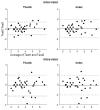Validity and Reliability of the Semmes-Weinstein Monofilament Test and the Thumb Localizing Test in Patients With Stroke
- PMID: 33584520
- PMCID: PMC7873561
- DOI: 10.3389/fneur.2020.625917
Validity and Reliability of the Semmes-Weinstein Monofilament Test and the Thumb Localizing Test in Patients With Stroke
Abstract
Background: Somatosensory impairment is common in patients who have had a stroke and can affect their motor function and activities of daily living (ADL). Therefore, detecting and treating somatosensory impairments properly is considered to be very important, and various examinations have been developed. However, the reliability and validity of few of them have been verified due to differences in the procedure of each examiner or poor quantification by the examination itself. Objective: We hypothesized that, with fixed procedures two convenient clinical examinations, the Semmes-Weinstein Monofilament Test (SWMT) and the Thumb Localizing Test (TLT), could provide reliable assessments of light touch sensation and proprioception. The purpose of this study was to verify the reliability and validity of these two examinations as indices of somatosensory impairment of the upper extremity (UE) in patients with chronic post-stroke hemiparesis. Methods: Fifty patients with chronic stroke (median time after onset of stroke, 848 [474-1708] days, mean age 57 [standard deviation 14] years) were enrolled at Keio University Hospital from 2017 to 2018. Examiners learned the original method of the SWMT and the TLT rigorously and shared it with each other. The TLT procedure was partially modified by dividing the location of the patient's thumb into four spaces. Two examiners evaluated the SWMT and the TLT for 2 days, and intra-rater and inter-rater reliabilities were calculated using weighted kappa statistics. In addition to this, the evaluator size score of the SWMT was assessed with Bland-Altman analysis to evaluate systematic bias. The Stroke Impairment Assessment Set (SIAS) sensory items were used to assess validity, and Spearman's rank correlation coefficients were calculated. Results: Intra/inter-rater agreements of the SWMT grade score were 0.89 (thumb, 95%CI: 0.83-0.95)/ 0.75 (0.60-0.91) and 0.80 (index finger, 0.67-0.93)/0.79 (0.66-0.92), and of the TLT they were 0.83 (navel level proximal space, 0.71-0.95)/ 0.83 (0.73-0.92), 0.90 (navel level distal space, 0.85-0.96)/ 0.80 (0.69-0.90), 0.80 (shoulder level proximal space, 0.68-0.92)/ 0.77 (0.65-0.89), and 0.87 (shoulder level distal space, 0.80-0.93)/ 0.80 (0.68-0.92) (P < 0.001, each item). All of them showed substantial agreement, but the MDC of the SWMT evaluator size was 1.28 to 1.79 in the inter-rater test and 1.94-2.06 in the intra-rater test. The SWMT grade score showed a strong correlation with the SIAS light touch sensation item (r = 0.65, p < 0.001), as did the TLT with the SIAS position sense item (r = -0.70-0.62, p < 0.001 each space). Conclusions: The reliability and validity of the SWMT and the TLT were verified. These tests can be used as reliable sensory examinations of the UE in patients with chronic stroke, and especially for the SWMT, it is more reliable for screening.
Keywords: Semmes-Weinstein monofilament test; assessment; rehabilitation; somatosensory disorders; stroke; thumb localizing test.
Copyright © 2021 Suda, Kawakami, Okuyama, Ishii, Oshima, Hijikata, Nakamura, Oka, Kondo and Liu.
Conflict of interest statement
The authors declare that the research was conducted in the absence of any commercial or financial relationships that could be construed as a potential conflict of interest.
Figures


Similar articles
-
Relationship between Semmes-Weinstein Monofilaments perception Test and sensory nerve conduction studies in Carpal Tunnel Syndrome.NeuroRehabilitation. 2014;35(3):543-52. doi: 10.3233/NRE-141150. NeuroRehabilitation. 2014. PMID: 25238864
-
Reliability of the thumb localizing test and its validity against quantitative measures with a robotic device in patients with hemiparetic stroke.PLoS One. 2020 Jul 24;15(7):e0236437. doi: 10.1371/journal.pone.0236437. eCollection 2020. PLoS One. 2020. PMID: 32706817 Free PMC article.
-
Reliability and validity of the modified McGowan grade in patients with cubital tunnel syndrome.Arch Orthop Trauma Surg. 2022 Jul;142(7):1697-1703. doi: 10.1007/s00402-022-04367-8. Epub 2022 Feb 2. Arch Orthop Trauma Surg. 2022. PMID: 35107635
-
Neuromuscular electrical stimulation-enhanced rehabilitation is associated with not only motor but also somatosensory cortical plasticity in chronic stroke patients: an interventional study.Ther Adv Chronic Dis. 2019 Nov 20;10:2040622319889259. doi: 10.1177/2040622319889259. eCollection 2019. Ther Adv Chronic Dis. 2019. PMID: 31798821 Free PMC article.
-
The reliability and applicability of the Ten Test in hand injuries: A systematic review.Hand Ther. 2024 Jun;29(2):44-51. doi: 10.1177/17589983241230249. Epub 2024 Jan 28. Hand Ther. 2024. PMID: 38827650 Free PMC article. Review.
Cited by
-
Effects of an assist-as-needed equipped Tenodesis-Induced-Grip Exoskeleton Robot (TIGER) on upper limb function in patients with chronic stroke.J Neuroeng Rehabil. 2024 Jan 3;21(1):5. doi: 10.1186/s12984-023-01298-2. J Neuroeng Rehabil. 2024. PMID: 38173006 Free PMC article. Clinical Trial.
-
Musculoskeletal complaints, physical work demands, and functional capacity in individuals with a brachial plexus injury: An exploratory study.Work. 2024;77(3):811-825. doi: 10.3233/WOR-220680. Work. 2024. PMID: 37781839 Free PMC article.
-
Use of Iontophoresis with Corticosteroid in Carpal Tunnel Syndrome: Systematic Review and Meta-Analysis.Int J Environ Res Public Health. 2023 Feb 28;20(5):4287. doi: 10.3390/ijerph20054287. Int J Environ Res Public Health. 2023. PMID: 36901312 Free PMC article.
-
Functional capacity of individuals with brachial plexus injury.Work. 2023;76(3):1019-1030. doi: 10.3233/WOR-220414. Work. 2023. PMID: 37248939 Free PMC article.
-
Effects of device-assisted practice of activities of daily living in a close-to-normal pattern on upper extremity motor recovery in individuals with moderate to severe stroke: study protocol of a randomized control trial.Trials. 2025 Jul 4;26(1):238. doi: 10.1186/s13063-025-08930-7. Trials. 2025. PMID: 40616111 Free PMC article.
References
-
- Carey LM. Somatosensory loss after stroke. Crit Rev Phys Rehabil Med. (1995) 7:51–91. 10.1615/CritRevPhysRehabilMed.v7.i1.40 - DOI
LinkOut - more resources
Full Text Sources
Other Literature Sources
Medical

